Scottish Crime and Justice Survey 2014/15: Drug Use
This report presents findings on illicit drug use from the self-completion module of the Scottish Crime and Justice Survey. It provides data and analysis on drug use in the last month, in the last year and ever among adults aged sixteen and over in Scotla
Chapter 3: The Experiences of Adults Reporting Drug Use in Scotland
Key findings
Self-reported drug use in the last year
- Of the 6.2% of adults who reported taking any drugs (including 'new' drugs) in the last year, eight in ten (80.7%) said that they had used cannabis; 29.3% said they had used cocaine and 21.7% said they had used ecstasy.
Polydrug use and mixing alcohol with drug use
- Of all adults over 16 taking more than one drug in the last year, half (50.6%) reported that they had taken different drugs together at the same time.
- Of all adults who reported using drugs in the last year, nearly two thirds (64.8%) reported that they had consumed alcohol at the same time as taking drugs.
First drug use
- The most common age for first trying drugs was the late teens (16-19) with over half (55%) of those who had reported taking drugs at some point in their lives first trying them at this age.
- The majority of adults who have ever taken drugs reported that their first drug used was cannabis (77.8%).
Methods of taking drugs
- Of those adults who reported having used drugs at some point in their lives, the majority (92.7%) said that that they had taken them by smoking, sniffing or inhaling them.
Experiences of drug use in the last month
Frequency of drug use
- Of those who reported using drugs in the last month, most adults reported using their most frequently used drug once or twice a month (40.5%) followed by almost on a daily basis (18.8%).
- There has been a statistically significant decrease from 30.2% in 2012/13 to 18.8% in 2014/15 in those reporting that they used their most frequently used drug in the last month 'every day or almost every day'.
Dependency
- 82.5% said that they did not feel dependent on the drug taken most often in the last month.
- 31.3% of adults living in the 15% most deprived areas in Scotland said that they had felt dependent on the drug taken most often in the last month, compared to 11.9% of those living in the rest of Scotland.
- For those respondents who had in the last month tried to cut down on the drug used most often in the last month, the majority (87.4%) said that they did not use any support services while trying to cut down.
Ease of obtaining drugs
- The majority of those who had used drugs in the last month said that this was very easy (40.5%) or fairly easy (43.4%) to get hold of the drug used most often in the last month.
3.1 Introduction
This chapter focuses on the experiences of those who reported drug use. Unlike Chapter 2, Chapter 3 includes 'new drugs' in the analysis, as the focus of this chapter is on the experiences of those taking drugs, both illicit and new. Including 'new drugs', 22.6% of all adults over 16 said that they had used one or more drugs at some point in their lives. Of the adults who had used any drugs at some point in their lives, over one quarter (27.2%) had used drugs in the last year. Just over one in twenty of all adults (6.2%) said that they had used one or more drugs in the last year with 3.3% saying that they had used one or more drugs in the last month.
This chapter begins by examining self-reported drug use in the last year before then examining experience of drug use in the last year with regards to specific drugs; polydrug use; and joint use of alcohol and drugs. This chapter then examines the age at which drugs were first used; the type of drug first used; and methods of taking drugs. The final section of this chapter specifically focuses on the experiences of adults over 16 who have used one or more drugs in the last month looking at frequency of use, variation by age and gender in frequency of use; drug dependency; ease of obtaining drugs in the last month; and accessibility of drugs. This chapter has a particular focus on drug use in the last month as this time frame is most useful when examining drug dependency.
3.2 Self-reported drug use in the last year
Looking only at those respondents who reported using drugs in the last year (Base: 490), Figure 3.1 shows the percentage of adults who had used each specific drug.
- Eight in ten adults (80.7%) who reported using any drugs (including "new drugs") in the last year said that they had used cannabis in that time.
- Of adults taking drugs in the last year, the next most commonly used drugs were cocaine (29.3%), ecstasy (21.7%), poppers (10.5%) and amphetamines (10.3%).
- Of all adults taking drugs in the last year, 46.1% said that they had taken stimulants; 7.7% said that they had used downers/tranquilisers; 7.5% said that they had taken psychedelics; and 3.4% said that they had taken opiates.
- Of those who reporting using drugs in the last year, the proportion using tranquilisers fell by 8.9 percentage points between 2010/11 and 2014/15. There have been no other statistically significant changes looking at the above drugs.
Figure 3.1: % each drug type used where used one or more drugs in the last year
SCJS 2014/15
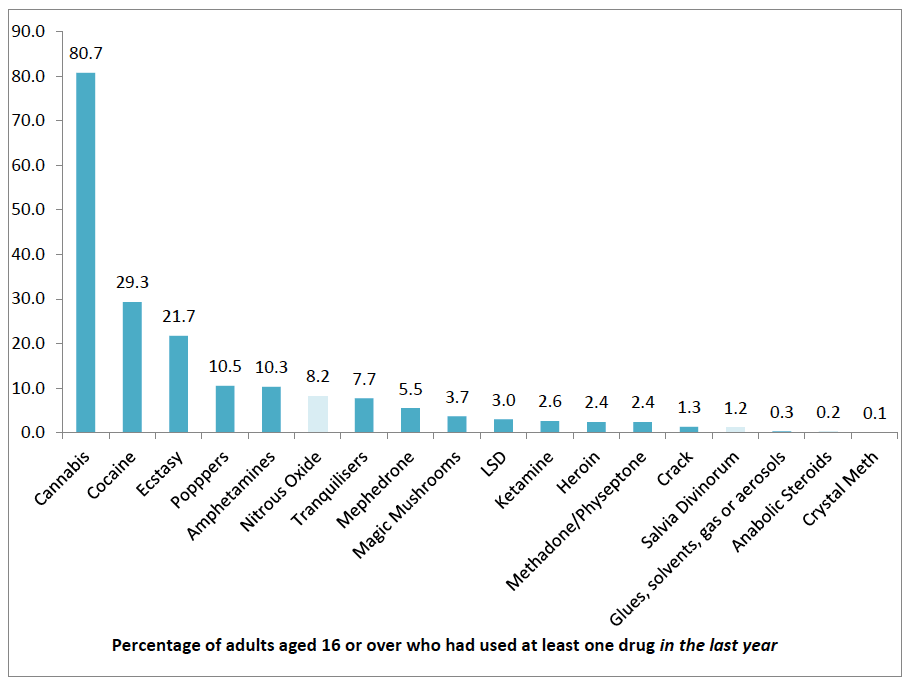
Base: Adults aged 16 and over who had used at least one drug in the last year (490)
Variable Name: Q12M
3.2.1 Experiences of drug use in the last year by specific drugs
This section will focus on the experience of drug use in the last year by examining experiences of the most commonly used drugs in the last year; polydrug use; and joint consumption of alcohol and drugs.
Experiences of use of most prevalent drugs
Cannabis
As previously mentioned, cannabis is the most used drug in the last month, last year and ever. All adults over 16 who had used cannabis in the last year were asked to describe their use of this drug. Of adults who reported using cannabis in the last year (Base: 390):
- Over a quarter of adults (26.9%) said that it was something that they had tried once or twice;
- Over three fifths of adults (62.3%) said that it was something that they had used more than once or twice but would not or did not have difficulty giving it up if they wanted to;
- One in ten adults (10%) said that cannabis was something that they needed or were dependent on at the time of the survey or in the last year.
Cocaine
Cocaine was the next most commonly used drug in the last year after cannabis. Of adults who reported using cocaine in the last year (Base:140):
- Two fifths of adults (40.1%) said that it was something that they had tried once or twice;
- More than half of adults (58.6%) said that it was something that they had used more than once or twice but would not or did not have difficulty giving it up if they wanted to;
- 1.3% of adults said that cocaine was something that they needed or were dependent on at the time of the survey or in the last year.
Ecstasy
Ecstasy was the third most commonly used drug in the last year. Of adults who reported using ecstasy in the last year (Base: 90):
- Just over two fifths of adults (45.5%) said that it was something that they had tried once or twice;
- More than half of adults (54.5%) said that it was something that they had used more than once or twice but would not or did not have difficulty giving it up if they wanted to;
- No respondents said that ecstasy was something that they needed or were dependent on at the time of the survey or in the last year.
3.2.2 Polydrug use
Polydrug use is the use of more than one drug at the same time, often with the intention of enhancing or countering the effect of another drug. Respondents who reported taking more than one type of drug in the last year were asked whether they had taken different drugs together at the same time during this period. Of all adults over 16 taking more than one drug in the last year (Base: 190), half of adults (50.6%) reported that they had taken different drugs together at the same time and 49.1% said that they had not.
3.2.3 Alcohol and drug use
Those who had used drugs in the last year were asked whether they had consumed alcohol at the same time as taking drugs. Nearly two thirds of adults (64.8%) reported that they had consumed alcohol at the same time as taking drugs (of all adults who reported using drugs in the last year - base: 490). Joint consumption of alcohol at the same time as taking drugs varies significantly [30] with socioeconomic classification.
- Those in the managerial/professional socioeconomic group were more likely to report consuming alcohol at the same time as taking drugs in the last year (84.8%) in comparison to 61.3% of adults in the intermediate group; 63.3% of adults in the routine and manual socioeconomic group; and 57.6% of adults in the not working and long-term unemployed group.
3.3 Experiences of adults who have taken drugs at some point in their lives
This section will explore experiences of drug use of all adults who reported taking drugs at some point in their lives (Base: 2110) through examining: age at which drugs used were first taken; first drug ever used; and methods of taking drugs.
3.3.1 Age at which drug first taken
All adults aged 16 and over who reported having ever taken drugs were asked what age they were when they first took drugs. Figure 3.2 shows that:
- The most common age for first trying drugs was the late teens (16-19) with over half (55.0%) of those who had reported taking drugs at some point in their lives first trying them at this age;
- Two fifths of adults (20.8%) said that they had first used drugs aged under 16;
- 15.9% of adults said that they had first used drugs aged 20-24; and
- A small proportion of adults report having first used drugs over the age of 25. (see Figure 3.2)
Figure 3.2: Age at which drugs were first taken
SCJS 2014/15
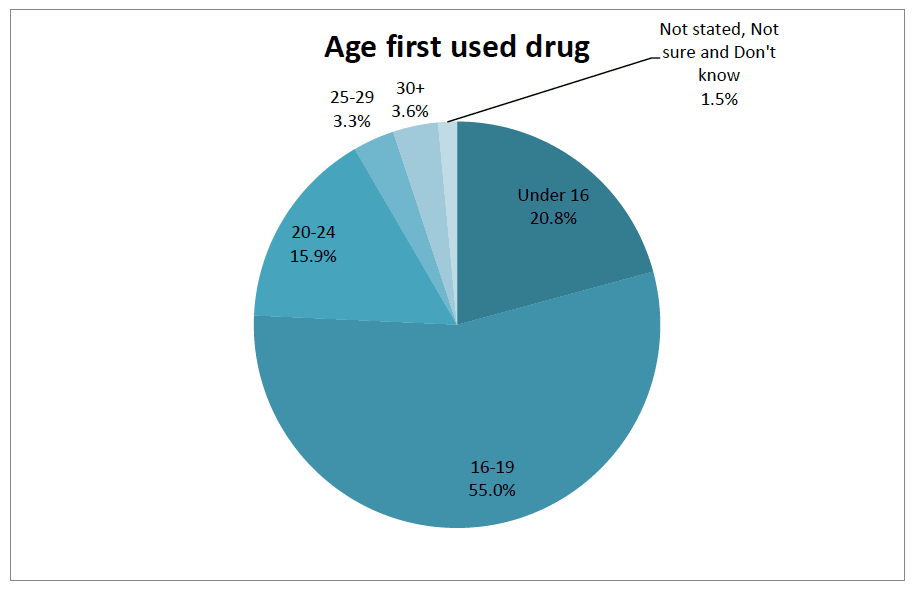
Base: Adults aged 16 and over who had used at least one drug ever (2,110)
Variable Name: QDRAGE
3.3.2 First drug ever used
Respondents who had ever used one or more drugs were asked what the first drug they had ever used was. The majority of adults reported that their first drug used was cannabis (77.8%). Of the rest of first drugs ever used (see Figure 3.3):
- Over one in ten adults (11.5%) reported that their first drug used was any stimulant drug with 2.3% having first tried ecstasy. 3.0% stated amphetamines, 4.2% stated poppers and 1.9% stated cocaine as their first drug used.
- 3.5% said that their first drug used was a psychedelic drug including 2.0% that stated magic mushrooms and 1.5% that stated LSD as first drug used.
- 3.0% of adults reported that their first drug used was a new drug - salvia divinorum (0.2%) or nitrous oxide (2.8%).
- 2.2% said that their first drug used was glues, solvents, gas or aerosols.
- 0.8% of adults reported that their first drug used was any tranquilisers/downers.
- 0.1% of adults reported that their first drug used was heroin.
Cannabis was the most commonly stated drug first used for all age ranges. Of those who were under 16 years when they first used drugs, 9.3% said that their drug first used was either glues, solvents, gas or aerosols. Of those aged 16-19 when they first used drugs, 0.4% said that their first drug used was either glues, solvents, gas or aerosols.
Figure 3.3: First drug ever used
SCJS 2014/15
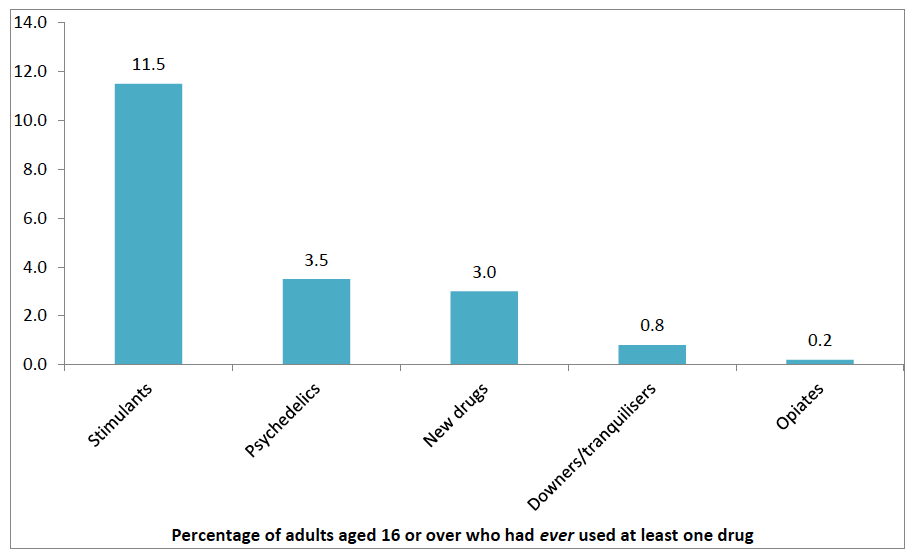
Base: Adults aged 16 and over who had used at least one drug ever (2,110)
Variable Name: QDR1ST
3.3.3 Methods of taking drugs ever tried
Of those adults who reported having used drugs at some point in their lives, the majority (92.7%) said that that they had taken them by smoking, sniffing or inhaling them. Two in five (40%) reported that they had tried to swallow, eat or drink drugs. A small proportion of adults said that they had injected drugs (1.9%) or used another method (1.4%).
3.4 Experiences of drug use in the last month
This section examines experiences of drug use in the month prior to the survey interview. It examines:
- the single drug reported as being used most often in the month prior to the survey interview;
- the frequency with which that drug was used;
- perceptions of dependency on that drug and
- access to that drug.
Looking at those who had used drugs in the last month (Base: 260), it was found that:
- More than three quarters of adults (77.3%) reported that cannabis was their most frequently used drug in the last month;
- Around one in twenty (6.9%) reported that cocaine was their most frequently used drug in the last month;
- Stimulants were the most used drug in the last month (16.2% of adults reported use of this composite group).
- No adults reported crack, LSD, magic mushrooms, crystal meth, ketamine, salvia divinorum, nitrous oxide, methadone/physeptone or glues, solvents, gas or aerosols as the drug used most often in the last month.
3.4.1 Drug used more often in the last month - frequency of use
Figure 3.4 illustrates the frequency with which adults used their most frequently used drug in the month prior to the survey interview. Most adults reported using their most frequently used drug once or twice a month (40.5%) followed by almost on a daily basis (18.8%) and 1-2 days each week (18.0%).
Figure 3.4: Proportion of respondents who reported drug use in the last month by how frequently they have used the drug they use most often
SCJS 2014/15
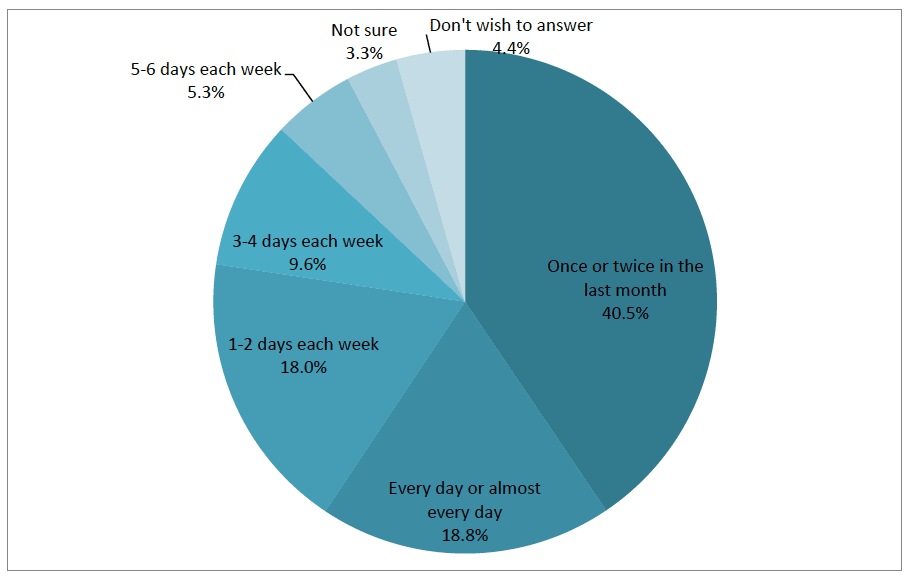
Base: adults aged 16 and over who had used at least one drug in the last month (260)
Variable Name: QDROFT
There has been a statistically significant decrease from 30.2% in 2012/13 to 18.8% in 2014/15 in those reporting that they used their most frequently used drug in the last month 'every day or almost every day'. However, the change between 2008/09 and 2014/15 is not significant, as shown in Table 3.1.
Table 3.1: Trends in frequency of use of the drug used most often in the last month from 2008/09 to 2014/15
SCJS 2008/09; SCJS 2009/10; SCJS 2010/11; SCJS 2012/13; SCJS 2014/15
| Percentage of adults aged 16 and over who had used a drug in the last month | 2008/09 | 2009/10 | 2010/11 | 2012/13 | 2014/15 | pp change 2008/09 - 2014/15 |
pp change 2012/13 - 2014/15 |
|---|---|---|---|---|---|---|---|
| Once or twice in last month | 38.1 | 34.5 | 37.4 | 34.1 | 40.5 | 2.4 | 6.4 |
| Every day or almost every day | 20.9 | 16.5 | 24.3 | 30.2 | 18.8 | -2.1 | -11.4 |
| Base | 380 | 440 | 310 | 270 | 260 |
Base: Adults who have taken drugs in the last month
Variable: QDROFT
3.4.2 Variation by gender and age in drug used most often in the last month and frequency of use
Frequency of use of the drug used most often in the last month varied by gender and by age. Frequency of drug use on an almost daily basis and frequency of drug use once or twice a month were specifically examined. [31]
For those aged 16-24 and 25-44, most adults reported using their most frequently used drug once or twice a month (47.6% and 38.0%). Amongst the same age groups, 20.3% of those aged 16-24 and 16.6% of 25-44 year-olds reported using their most frequently used drug on an almost daily basis.
Figure 3.5 illustrates the association between gender and frequency of drug use for the drug used most often in the last month. It illustrates that men were more likely to report using their most frequently used drug on an almost daily basis in the last month (19.8%) in comparison to women (15.1%). Women were more likely to report using their most frequently used drug once or twice in the last month (52.9%) in comparison to men (37.1%).
Figure 3.5 % frequency of drug use in the last month by gender
SCJS 2014/15
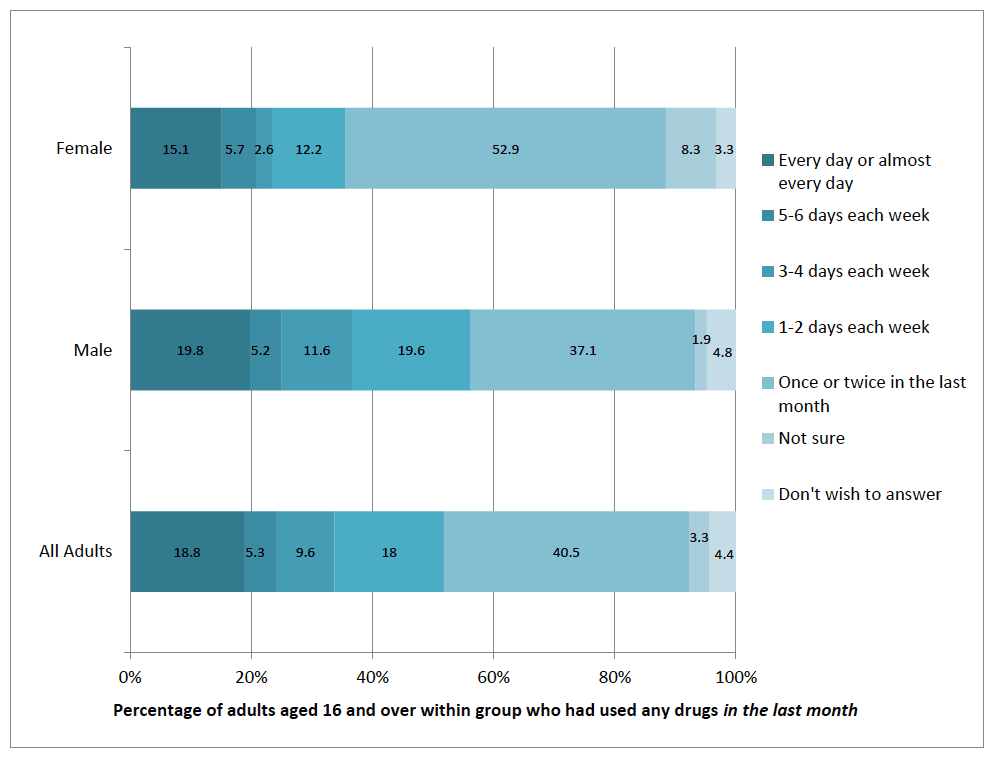
Base: Adults, males and females aged 16 or over who had used at least one drug in the last month (Adults: 260; Males: 200; Females: 70)
Variable Name: QDROFT
3.4.3 Drug Dependency
Of those who had used at least one drug in the last month (3.3% of adults, Base: 260):
- 82.5% said that they did not feel dependent on the drug taken most often in the last month.
- Less than a fifth (16.6%) said that they felt dependent upon the drug they used most often in the last month;
- More than a third (35.1%) said that they had tried to cut down on the drug they used most often in the last month;
- More than two fifths (41.5%) reported that they had felt dependent on the drug used most often in the last month OR had tried to cut down but could not;
- A tenth (10.3%) reported that they felt dependent AND tried to cut down;
- More than half (56.7%) reported that they did not feel dependent nor had tried to cut down.
For those respondents who had in the last month tried to cut down on the drug used most often (Base: 100), the majority (87.4%) said that they did not use any support services while trying to cut down on the drug used most often in the last month. The remainder of the respondents either said that they had used any support services (7.3%) or that they did not know that help was available (5.3%).
Drug dependency by specific drug
Of those who had used at least one drug in the last month (Base: 260), when asked about the drug they used most often, 12.5% of adults who used cannabis most often reported feeling they needed or were dependent on this drug. This compares 20.1% of adults in the SCJS 2012/13. Very few respondents reported feeling they needed or were dependent on the other the drugs used most in the previous month.
Variation in drug dependency
There was a statistically significant [32] difference in drug dependency by area deprivation (of all adults who had used drugs in the last month - Base: 260) (see Figure 3.6).
- 31.3% of adults living in the 15% most deprived areas in Scotland said that they had felt dependent on the drug taken most often in the last month, compared to 11.9% of those living in the rest of Scotland.
Figure 3.6: % reporting they felt dependent on or needed the drug taken most often in the last month by SIMD index
SCJS 2014/15
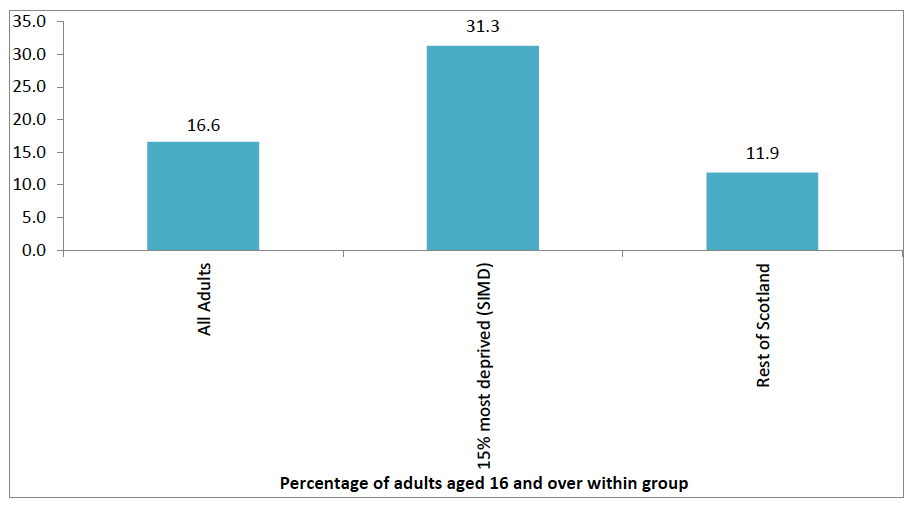
Variable Names: QDEP1; SIMD_TOP
Base: SIMD Index (All adults: 260; 15% most deprived: 70; All other areas: 190).
3.4.4 Ease of obtaining drugs in the last month
Those who had taken drugs in the last month (Base: 260) were asked how difficult it was to get hold of the drug used most often in the last month. The majority said that this was very easy (40.5%) or fairly easy (43.4%) whilst far fewer said that it was either fairly difficult (13.1%) or very difficult (1.9%) to get hold of the drug used most often in the last month.
The Scottish Household Survey 2014 [33] asked respondents about their perceptions on the prevalence of a range of 'neighbourhood problems' including 'drug misuse or dealing'. 11% of all adults reported that 'drug misuse or dealing' was very/fairly common in their neighbourhood. People living in social rented housing (24%) were more likely to view drug misuse or dealing as very/fairly common, compared to owner occupiers (7%) and private renters (10%) (Scottish Government, 2015). http://www.gov.scot/Resource/0048/00484186.pdf
3.4.5 Access to drugs in the last month
Those who had taken drugs in the last month (Base: 260) were asked who or where they got the drug used most often in the last month from, with specific reference to the last time they took the drug.
- Over a third (35.1%) said that they had got their drug taken most often in the last month, the last time they used it, from "someone else well known" to them ( e.g. a friend, neighbour or work colleague).
- Just under one in five (17%) said that they got it from a known dealer.
- Just over one in ten (13.1%) said that they got it from a dealer not known to them personally.
- 11.7% said that they got it from someone known to them only by sight or to speak to casually.
- The remainder said that they had either got it from a stranger (5.4%), from a shop (2.4%), from a family member (2.9%) or from the internet (0.6%).
Contact
There is a problem
Thanks for your feedback